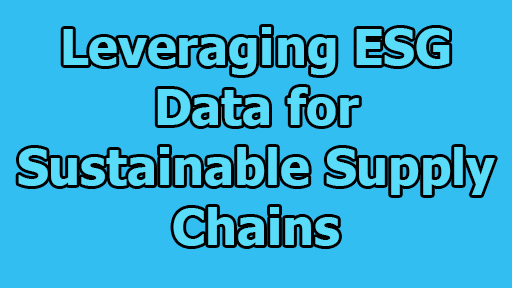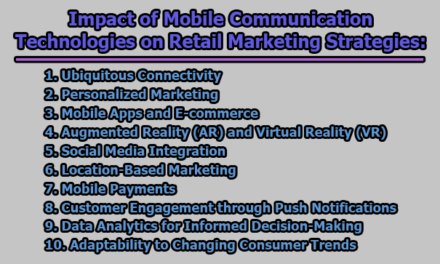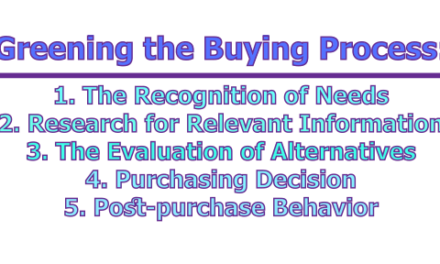Leveraging ESG Data for Sustainable Supply Chains:
In an era where environmental and social consciousness is on the rise, businesses are under increasing pressure to adopt sustainable practices. ESG data, which stands for Environmental, Social, and Governance data, is playing a pivotal role in this transformation. ESG data is not just a tool for investors, customers, and regulators; it’s also a powerful resource for improving supply chain sustainability. In this article, we will explore leveraging ESG data for sustainable supply chains.
Why Supply Chain Sustainability Matters:
Supply chain sustainability is not just a moral obligation but also a strategic advantage for businesses. It encompasses a wide range of benefits that include cost reduction, improved efficiency, enhanced reputation, increased customer loyalty, regulatory compliance, risk mitigation, and the creation of value. A sustainable supply chain also aligns with the United Nations Sustainable Development Goals, which aim to end poverty, protect the planet, and ensure peace and prosperity for all by 2030.
What ESG Data Can Reveal:
ESG data provides insights into various aspects of sustainability, such as carbon emissions, water use, waste management, human rights, labor standards, diversity, inclusion, anti-corruption, health and safety, and more. By analyzing this data, businesses can understand how they and their suppliers perform on sustainability metrics. ESG data helps identify gaps, opportunities, and best practices in supply chain sustainability while allowing benchmarking against peers and industry standards. Moreover, it aids in communicating sustainability efforts and achievements to stakeholders, including investors, customers, employees, regulators, and the public.
How to Collect and Analyze ESG Data:
Collecting and analyzing Environmental, Social, and Governance (ESG) data is a crucial step for businesses looking to enhance their sustainability performance. Here’s a look at the process of collecting and analyzing ESG data:
1. Define Sustainability Goals: Begin by setting clear sustainability objectives for your supply chain. These goals should align with your overall business strategy and reflect your commitment to environmental responsibility, social equity, and good governance. Ensure that these goals are specific, measurable, achievable, relevant, and time-bound (SMART) to provide a clear framework for assessment.
2. Identify Material Issues: Determine which aspects of ESG data are most relevant to your business and its stakeholders. Materiality assessments help you identify the issues that have the most significant impact on your sustainability efforts and are of greatest concern to your stakeholders. Consider conducting surveys, consultations, or stakeholder engagement to gain insights into what matters most to your stakeholders.
3. Select Indicators and Metrics: After identifying material issues, choose the key performance indicators (KPIs) and metrics that are most relevant to your sustainability goals. These metrics will allow you to measure and track your progress accurately. Common ESG indicators include carbon emissions, water usage, waste management, diversity and inclusion, labor standards, and more. Select indicators that align with your sustainability objectives.
4. Establish Data Sources and Methods: Determine where and how you will collect ESG data. This involves identifying the sources of data and the methods for data collection. Data sources may include internal records, supplier reports, third-party databases, and surveys. Collaboration with suppliers, industry partners, and relevant organizations can be beneficial in obtaining necessary data. Data collection methods can range from self-reporting and audits to automated data capture and integration through software platforms.
5. Utilize Tools and Frameworks: To streamline the data collection and analysis process, consider utilizing established tools and frameworks such as:
- Global Reporting Initiative (GRI): Offers guidelines for sustainability reporting.
- Sustainability Accounting Standards Board (SASB): Provides industry-specific standards for ESG reporting.
- Task Force on Climate-related Financial Disclosures (TCFD): Focuses on climate-related financial disclosures.
- Carbon Disclosure Project (CDP): Encourages companies to disclose their environmental impact.
- Social Accountability International (SAI): Emphasizes social responsibility and labor standards.
These tools help ensure that your data collection and reporting align with industry best practices and standards.
6. Leverage Software Platforms: Consider using software platforms like EcoVadis, Enablon, and Sustainalytics. These platforms can automate data collection, integrate information from various sources, and provide tools for data analysis and reporting. Automation through software can save time and resources while improving the accuracy and efficiency of data collection and analysis.
Collecting and analyzing ESG data is an essential process for improving supply chain sustainability. By defining sustainability goals, identifying material issues, selecting relevant indicators and metrics, establishing data sources and methods, and leveraging tools and software platforms, businesses can not only meet their sustainability objectives but also demonstrate their commitment to responsible business practices. This approach benefits not only the company but also its stakeholders and the broader global community through a more sustainable and ethical supply chain.
How to Use ESG Data to Improve Supply Chain Sustainability:
Using ESG data to enhance supply chain sustainability is a multi-faceted endeavor. Businesses should:
- Set Targets and Track Progress: Establish sustainability targets based on ESG data insights and monitor progress.
- Engage with Suppliers and Customers: Initiate conversations with suppliers and customers to address sustainability issues and foster collaborative solutions.
- Implement Sustainability Policies and Practices: Incorporate sustainability into company policies and supply chain practices.
- Invest in Innovation and Technology: Allocate resources to innovations and technologies that enhance sustainability performance and efficiency.
- Report and Disclose Results: Communicate sustainability outcomes and impacts to stakeholders through transparent reporting and disclosure mechanisms.
All these actions, when executed effectively, can significantly improve supply chain sustainability.
How to Leverage ESG Data for Competitive Advantage:
Leveraging ESG data can provide a competitive edge. Businesses can:
- Differentiate Products and Services: Highlight sustainability features and benefits to attract environmentally and socially conscious consumers.
- Attract and Retain Stakeholders: Attract investors, customers, and employees who value sustainability, thereby strengthening the brand and reputation.
- Reduce Costs and Risks: Minimize costs and risks associated with sustainability issues and regulations.
- Enhance Reputation: Develop a reputation as a sustainability leader and innovator.
- Collaborate for Common Goals: Partner with businesses and organizations that share sustainability goals and values to further mutual interests.
In conclusion, ESG data is a powerful tool that not only allows businesses to demonstrate their commitment to sustainability but also creates positive impacts for themselves, their stakeholders, and the world. In a rapidly evolving global landscape where sustainability is paramount, the effective collection, analysis, and application of ESG data are essential for securing a sustainable future for all.

Former Student at Rajshahi University










